
Salty Sam’s Fun Blog for Children
Number 151
Ancient Egyptians
Hello Everyone

A few weeks ago l was telling you about when Bill and Bob were learning about The Roman Empire coming to Britain. This week they were learning about an ancient culture that didn’t come to Britain but a culture that has always been a fascination to us. l am talking about Ancient Egypt.
lf you go to the British Museum in London to see all the artefacts (things) there, you will get a sense of the awe the archaeologists must have felt when they discovered these mystical treasures.
They come from a culture that existed about 5,000 years ago in northeast Africa.
The people that made these magnificent statues and other objects lived along the banks of the River Nile and were organised under the rule of a king called a ‘pharaoh’.
lt was their ability to organise themselves that made them so successful.
The region they lived in was not as dry as it is today. They could hunt in the surrounding countryside, which was not desert at that time but grassland with trees and animals.
They set up farming systems that domesticated animals (made wild animals into farm animals) and grew crops to harvest. ln this way, they had enough food to eat all year round.
They knew when the River Nile would flood each year, and when they needed to, they irrigated the fields. lrrigation means running water along channels dug into fields to allow water to get to crops in periods of dry weather.
The Ancient Egyptians grew barley and other grain crops to make bread and beer. They also grew grapes to make wine and many different kinds of vegetables like melons, leeks and lettuces and fruits like dates and figs.
They grew flax to make linen and used the papyrus plants that grew by the river to make a sort of paper to write and draw on.
They kept sheep, pigs, goats, ducks and geese. They used donkeys and oxen to help plough their fields.
Because the land was so fertile and food was quite easy to grow, people didn’t have to spend all their time working hard just trying to get enough to eat. They had time to turn their minds to other things…
They invented a writing system called hieroglyphs which represents one of the oldest languages known to us. This writing was a series of pictures rather than letters.
Hieroglyphic writing was a formal kind of writing which consisted of hundreds of symbols that represented words or sounds. We can see samples of it today because it was very often carved onto stone surfaces which have survived.
You know, if you have ever dropped your homework in a puddle on the way to school, that stone is tougher than paper!
Ancient Egyptians also had musical instruments, board games, soap and cosmetics. They knew how to make beautiful jars out of glass, they had effective medicines, good ship-building skills and they educated some of their children in writing and mathematics.
But what they were known for mostly was their architecture.
Buildings and enormous pyramids can still be seen in Egypt today and are visited by thousands of tourists every year.
The Ancient Egyptians were skilled builders and they also had a lot of manpower to move huge amounts of building materials.
The pyramids, of various sizes, were tombs (burial places) for the most important people in the country which were the kings and queens. These kings and queens were thought of like living gods.
The people had strong beliefs about the afterlife; they put all manner of riches and useful objects into the tomb with the souls to take with them into the next life, and the bodies were mummified (preserved) and wrapped in strips of linen.
Bill said that he thought he might dress up as a mummy next Halloween, but his mum said that there weren’t enough bandages in the medicine cabinet! ![]()
Bye bye everyone – don’t forget to subscribe to my blog!

Love and kisses
Salty Sam

www.christina-sinclair.com


Bill and Bob’s Joke of the Week![]()
![]()
Bill: How many archaeologists does it take to change a light bulb?
Bob: l don’t know Bill. How many archaeologists does it take to change a light bulb?
Bill: Four, one to change it, and three to argue about how old the old one was!

Salty Sam © Christina Sinclair 2015
Unauthorized use and/or duplication of material from this blog without express and written permission from this blog’s author and owner is strictly prohibited.
Links may be used to www.christina-sinclair.com

Picture Gallery

The Kingdom of Ancient Egypt was situated along the River Nile

Huge Egyptian statues can still be seen today

Hieroglyphs

Papyrus has a rougher surface than the paper we know today

Egyptian walls were painted in bright colours which have now largely faded

Figs

Flax

Dates growing on a palm tree

Some Ancient Egyptian buildings are now in ruins

The ancient ruins give us an idea of what the Ancient Egyptians lives looked like

Some are still standing like
Queen Hapshepsut’s Temple at Thebes Egypt
(Thebes is within Luxor on the River Nile)

This Assyrian carving shows some of the animals that were kept in the Middle East at that time

If you can’t afford to go to Egypt, you may be able to visit the British Museum

King Amenhotep II from Thebes 1400 BC

His throne is decorated on the sides with a symbol of the union of Upper and Lower Egypt

King Neotanebo I 370 BC

Part of a prayer in hieroglyphs

Two Egyptians sitting at a table
Tjitji and his wife Tjetji

A statue of Nenkheftka still with some of the original paint

A false door with writing giving the biography of Ptashepses

A grey granite papyrus column about 1500 BC – it is carved to look like a plant

A red granite head from a colossal figure of a king from the Temple of Mut about 1390 BC

Four black granite statues of the Goddess Sakhmet from the Temple of Mut at Thebes about 1400 BC – the Egyptians liked cats

A limestone bust (top) of Queen Ahmes-Merytamun from the Temple of Karnak at Thebes about 1550 BC – wife of King Amenophis I

A quartite block statue of Viceroy Tieti probably from Karnak 1450 BC
He isn’t short, he is sitting down and has his clothing over his knees!

Ramesses II from the Ramesseum western Thebes about 1270 BC

The side view of his head – it is enormous

Hieroglyphs with colour from the Temple of Ramesses II
The coloured paint is now faded

A sarcophagus is like a coffin – this one is shaped like a person
A sarcophagus from Thebes about 138 BC

The head of the sarcophagus

Black schist sarcophagus of Ankhnesheferibre from Thebes about 530 BC – it is covered in writing

A granite ram with King Taharqa from Nubia 690-664 BC
Nubia is a kingdom located in southern Egypt

A shrine of Ptolemy VIII Euergetes II and Cleopatra II
Pharaohs were thought of as gods on Earth

Cleopatra’s Needle on the banks of the River Thames

The benches nearby are decorated with Egyptian figures

Cleopatra’s Needle
There is an ancient obelisk in New York and Paris too

The monument is carved on all four sides
Obelisks are supposed to represent the first rays of the sunlight
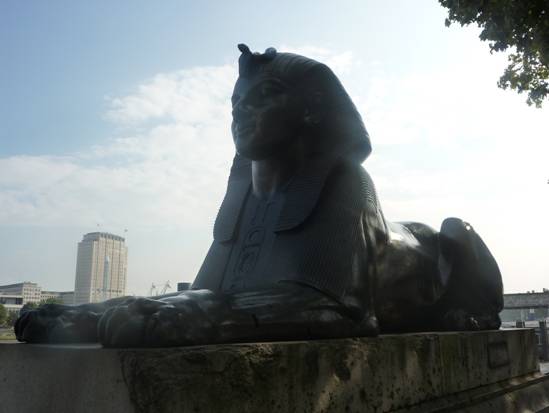
It is guarded by a sphinx each side

They have a body like a lion
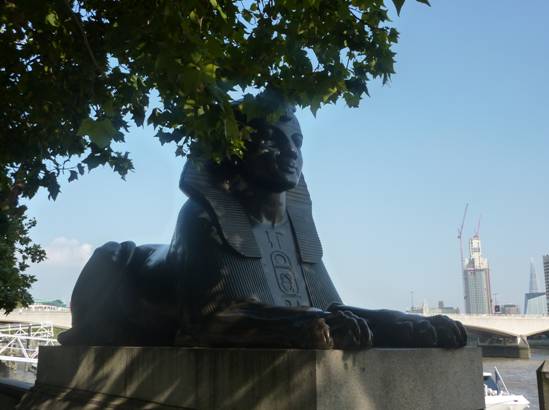
They have faces with Egyptian headdresses

The monument was brought from Egypt

It was found lying in the sand
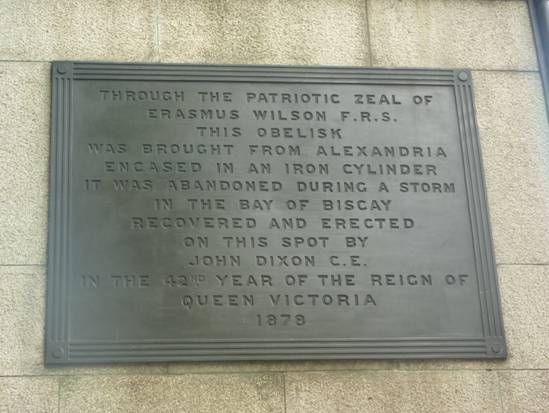
It was brought from Egypt by sea


 THE SALTY SAM NEWS DESK
THE SALTY SAM NEWS DESK

The ancient Egyptians thought that cats were sacred and if you are a cat lover, you will understand why they thought this.
On the news desk this week is another minimake idea and this time it is for a lucky cat.

To make a paper pattern all you have to do is draw around two jar lids, one smaller than the other and overlap the circles. Draw a centre line through the larger circle before you place the smaller circle on top in order to position the head correctly.
Then draw two triangular ears on top of the head.
Fold the paper pattern in half lengthways in order to check it is exactly symmetrical and trim if necessary.
NEWSDESK MINIMAKE
LUCKY BLACK CAT
- When you are happy that the cat is a good shape cut it out of two pieces of felt (front and back).
- Embroider a face and whiskers onto the front piece.
- Over-sew or blanket stitch the two shapes together leaving the bottom open until you have lightly stuffed the shape.
- NOTE: As you sew, incorporate a loop to hang your cat up if you want to, and add a tail to the inside of the back made from ribbon, cord or yarn that has chains crocheted into it, before you sew the shapes together.
- The cat in the photograph is made from a circle of 5cm/2 inches in diameter and a circle of 3cm/1¼ inches in diameter.
- The face of the cat in the photograph was embroidered with two strands of embroidery threads and the whiskers are just one strand and the tail was a double thickness of yarn with 10 chain stitches crocheted into it. The tail curls up naturally.
- The loop is 15cm/6 inches of narrow ribbon. The tail and the loop should be anchored into place onto the back piece of felt before the two pieces of felt are sewn together.
- The neck ribbon was added after the cat was constructed.
- If you prefer to make a lucky white cat, then of course one can be made in exactly the same way.
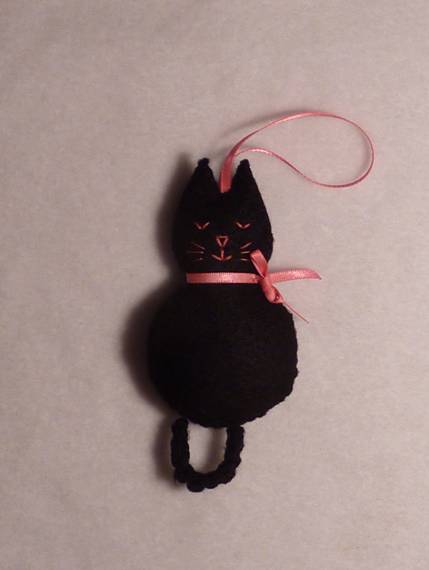

*********************
TO ADVERTISE ON THIS BLOG
PLEASE CONTACT:
christina.sinclair.ads@aol.co.uk
*********************


Quick Quiz
What do these phrases mean?
- as good as gold
- a golden handshake
- a golden opportunity
- the golden rule
- a gold-mine
- to kill the goose that laid the golden egg
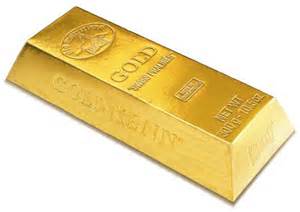

BLOW MY FOGHORN!!!

PLUS
Salty Sam fans can join in with their comments and share them with children all over the world. You will need to ask permission if you are not an adult.
Enter your e-mail address to subscribe to my blog and receive new Salty Sam Blog Posts for free by e-mail every week. Your address will be kept private and will not be shared with any third party.
Sign me up at the side bar




lt’s the Weekend!

HOW TO MAKE A PYRAMlD BOX
This is an easy box to make but looks very effective. It looks especially nice left on a plate as a table decoration with a gift inside for Christmas or it could be hung up on a Christmas tree.
You can make it out of coloured card or you can stick some wrapping paper onto the card first or even draw pictures or shapes on the card yourself with coloured pens.

Make sure you get an even coverage of glue between the card and paper if you choose to cover the card, and also that the glue is dry before you start cutting. But don’t use so much glue that the paper is over-wet otherwise it will wrinkle up.
Cut one template out of stiff card and this can be used over and over again.
Cut your boxes out of thin card so that you can fold the edges over neatly. (Card can be bought in different colours.)
The base of the box in the photograph is an 8cm square and the triangles are 10½cm in height.
You need to add flaps to the sides of the triangular sides as shown in the diagram.

- When you have prepared your card draw around your template and cut out the shape.
- Score along the inner sides of the tabs with a sharp knife – watch your fingers or get an adult to help you with this part!
- Make a hole with a hole-punch 2cm/¾ inch down from the tips of the points (marking the place first with a pencil) – be very careful that the hole does not come to the edge (watch where the cutter is coming down onto the surface of the card [from the side of the hole-punch] before you push it through the card).
- Fold the box up and place a little present inside.
- Seal it by threading a length of narrow wrapping ribbon through the holes – 20-30cm/8-12 inches should be enough.
- If you are using gift wrapping ribbon, pinch it between your thumb and the side of the ruler and pull the ribbon so that it curls up.

Please note that the material on this blog is for personal use and for use in classrooms only.
It is a copyright infringement and, therefore, illegal under international law to sell items made with these patterns.
Use of the toys and projects is at your own risk.
©Christina Sinclair Designs 2015


Quick Quiz Answers
- as good as gold –
- a golden handshake –
- a golden opportunity –
- the golden rule –
- a gold-mine –
- to kill the goose that laid the golden egg –
- well-behaved (usually children)
- a large amount of money given to someone when they leave their job
- a good chance to get something worthwhile
- an important thing to remember when you are trying to do something
- something that will make you a lot of money
- to destroy something that made you money

Gold bars

For an Embroidery Stitches Chart
Check out Blog Post 3


Great article, totally what I needed.
l am glad you like my post Malinda. Thank you so much for writing in.